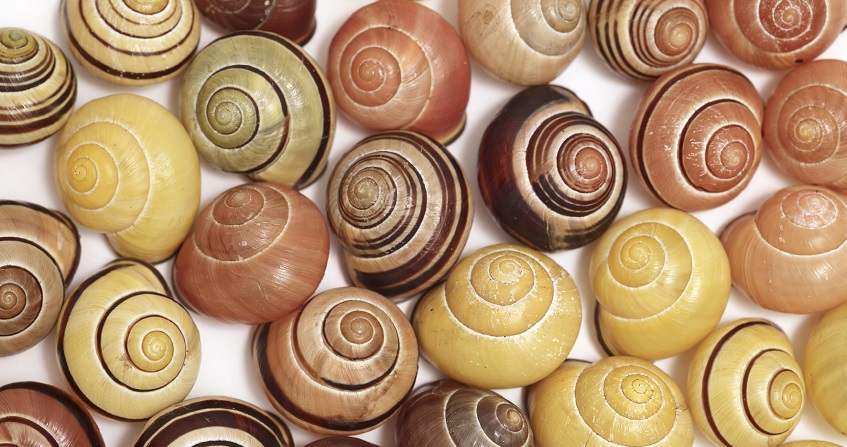太阳光中的紫外线对细胞的影响
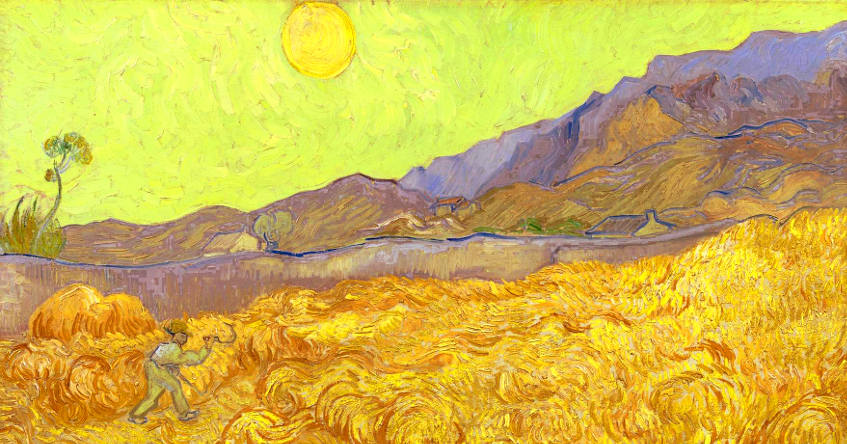
太阳对生命至关重要,无论是对植物的光合作用和人体维生素D的合成都是如此。然而,太阳也可能是危害的来源,尤其是通过它发出的电磁波中的紫外(UV)部分。事实上,太阳光中的紫外线会损伤细胞成分,特别是DNA,影响植物、微生物的生长,诱发人体皮肤癌,导致皮肤老化并造成眼睛损伤。
1. 太阳,一个复杂的辐射源
在穿过地球大气层之前,太阳光谱是一个波长范围很大的电磁辐射谱(参见“太阳光中的能量”),包括(图1):
- 无线电波;
- 红外辐射,有加热作用;
- 可见光;
- 紫外线(UV)部分。
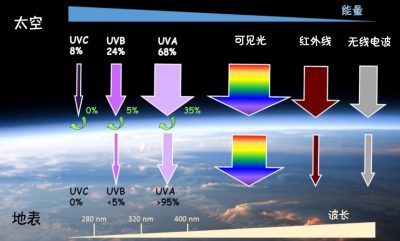
根据光子的能量(通过物理参数波长来测量,它与光子的能量成反比),我们将紫外线辐射人为地划分为三个波段。其中,UVC的波长小于280 纳米, UVB介于280到320 纳米之间,UVA介于320到400 纳米之间。在大气层之外,这三种紫外线辐射所占比例分别为8%、24%和68%。穿过大气层后,它们在太阳光中的比例发生了显著变化,原因在于臭氧层的作用。臭氧层吸收了全部UVC(能量最高的紫外线)、大部分UVB和一小部分UVA。到达地表的太阳辐射中,UVC、UVB和UVA的比例分别为0%、5%和95%,其中,UVB和UVA的相对占比还受其他因素的影响,如纬度(UVB在赤道更多)、海拔(UVB在山地更多)、时间(UVA在早晚更多)和反照率(地表对紫外线的反射)。世界卫生组织(WHO)将各种紫外线辐射都归为致癌物,太阳光是日常生活中紫外线辐射的来源,而我们经常暴露其中。
2. DNA,一种重要而脆弱的细胞成分
在阳光中过度暴露的主要危害之一是诱发皮肤癌。皮肤肿瘤形成的起始阶段通常是DNA损伤或病变。DNA在细胞的生命活动中起着至关重要的作用。首先,它是制造蛋白质的“食谱”,蛋白质维持细胞结构和各种功能。其次,DNA从母细胞复制到子细胞,保证了遗传信息的传递。DNA分子的这些重要功能源于其化学结构:它是由磷酸和糖为骨架的双链结构,其上连接着环状小分子——四种DNA碱基(腺嘌呤A、胸腺嘧啶T、鸟嘌呤G和胞嘧啶C),后者的排列顺序构成了遗传信息的基础。然而,各种化学或物理因素能够改变DNA的结构,进而可能损害这台美妙的机器。事实上,负责翻译或DNA复制的酶一旦遇到DNA损伤或病变就会发生停滞或者出错(参见“遗传多态性和变异”)。不幸的是,来自太阳的紫外线辐射是这些因素之一,能够格外有力地破坏我们的DNA,进而威胁基因组的完整性。
3. UVB,频率最低但最具攻击性
单个光子是如何破坏DNA双螺旋结构的?这取决于入射辐射的能量。UVB辐射对DNA的损伤广为人知,其机制也相对简单。事实上,DNA上的碱基能够有效地吸收UVB光子,从而拥有过剩的能量,达到一种称为“激发”的物理状态,从激发态返回到基态的方法之一是就近发生化学反应。
在这种情况下,胸腺嘧啶(T)和胞嘧啶(C)这种嘧啶类的碱基最容易发生反应。因此,一个被激发的嘧啶可以与邻近的嘧啶形成共价键,生成二聚体光化学产物(因为它们是由光诱导产生,包括两个碱基)——嘧啶二聚体(T-T、T-C或C-C)。UVB对DNA的主要作用及其诱导的光化学产物现在已经非常明确。事实上,被阳光暴晒的皮肤会产生大量(生物学上的)DNA二聚体,大约每百万个碱基就有一个二聚体。
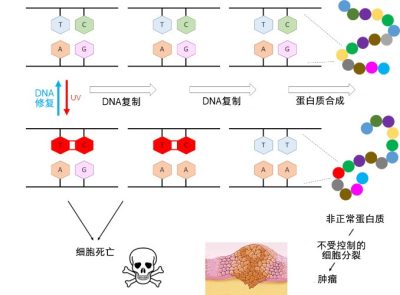
细胞有一套修复系统,以保护自身免受DNA化学结构变化的影响。人体细胞消除嘧啶二聚体的机制是将受损的一小段DNA切除,再以未受损的DNA链为模板重新合成“新的”DNA。这种修复系统如果有缺陷,就极易诱发皮肤癌,例如遗传性着色性干皮病。不过,即使是在没有缺陷的正常细胞中,DNA修复也并不完美,在DNA受损时仍然可能进行细胞分裂。负责DNA复制的酶能使用正常的ATGC碱基与受损片段上的碱基配对,使受损部分误译,从而导致基因序列改变(图2),由此产生的突变会传递给后代细胞。如果突变发生在控制细胞分裂的基因中,就可能诱发肿瘤。研究发现,在皮肤肿瘤中发生突变的位置是两个相邻的嘧啶,说明二聚体光化学产物起着关键性作用。DNA光化学产物还会诱导细胞死亡,有时是主动性的,如细胞凋亡,会将受损严重的细胞从组织中移除,产生的危害相对较小。
4. UVA,并非那么无害的辐射
长期以来,UVA辐射往往被人们所忽视,或被认为主要与皮肤老化有关,但现在发现它也能够诱发突变和肿瘤。虽然UVA诱导突变和肿瘤的效率不如UVB,但它的强度至少是UVB的20倍。UVA在皮肤细胞中的主要作用是产生氧化性化学物质,包括高度介导的“自由基”,以及较为隐蔽但同样有效的“单线态氧”,一种处于激发态的氧分子。这些化合物是由光敏反应产生的,当某些细胞成分吸收UVA,并将吸收的能量转移给氧气或从附近的分子中夺取电子时,这种反应就会被触发。
由此产生的活性氧会损伤细胞内的大分子:脂质、蛋白质……以及DNA。DNA氧化产物的性质多种多样,一些自由基会攻击生物大分子高聚物中的糖,导致其结构破坏。自由基和单线态氧也能改变DNA上的碱基,其中鸟嘌呤是尤其薄弱的环节,它很容易被氧化。更复杂的损伤甚至会导致DNA和蛋白质之间形成共价键(DNA-蛋白质交联)。由于氧化胁迫的巨大影响,推动了摄入抗氧化剂的保护策略的发展。
尽管人们经常强调UVA造成的氧化胁迫,但实际上它的影响远不止于此。近年来的研究表明,UVA也可以诱导DNA形成嘧啶二聚体,虽然产率远低于UVB,但是暴露于UVA中的细胞,其DNA二聚体的产生总量仍然比氧化产物的产生量更多。而且,和UVB一样,UVA诱导人体细胞突变主要发生在含有两个嘧啶的位点。虽然UVA的危害比UVB小,但它对阳光的遗传毒性的贡献不可忽视。值得一提的是,在考虑减少使用那些富含UVA的人造晒黑灯时,应该将这些数据考虑在内。因为使用晒黑灯无异于主动接触致突变和致癌物,对健康没有任何好处。
5. 需要有效的光保护
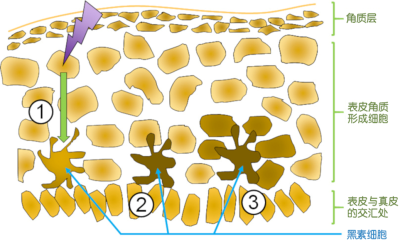
如前所述,太阳光中的紫外线辐射对健康有害。作为日常生活环境的一部分,我们不可能完全避免阳光照射;同时,接受一定量的紫外线也是人体所必需的,维生素D就主要源于皮肤所进行的光化学反应。然而,应该避免过度暴露,并采取光保护措施。皮肤受到太阳光尤其是UVB刺激时发生的一种自发性色素沉积反应就是一种天然的光保护机制,我们通常称之为晒黑。皮肤变黑是黑色素合成所致,它是一种聚合物,能够吸收从紫外线到可见光范围的太阳光。DNA损伤在晒黑过程中发挥了作用,其机制是嘧啶二聚体的形成促使定位于皮肤外层(表皮)的角质形成细胞向负责黑色素合成的黑素细胞发送信号(见图3),后者合成黑色素并将其通过黑素细胞树突转运到角质形成细胞,从而起到组织内部光保护器的作用。然而,晒黑并不能提供一种绝对的保护。首先,它只相当于指数为3-5的防晒霜;其次,黑色素的产生是皮肤对DNA受到攻击和损伤的一种反应,一些皮肤科医生甚至指出,晒黑会产生斑痕。简而言之,晒黑是一种人体降低损伤的自发反应,但并不能提供完全的保护。值得注意的是,通过美黑沙龙获得古铜色皮肤的做法更加不可取,那种肤色主要是通过UVA氧化原有的黑色素所得,新合成的黑色素很少。
因此,有必要采用其他手段来避免过度暴晒对健康的影响。第一种方法从原理上说相当简单,即避免过度暴露。不幸的是,当前的审美标准和众多娱乐活动促使一部分人在紫外线最强的时段暴露在阳光下。此外,许多职业也不得不经常暴露于日光(如农民、建筑工人等)。在这些情况下,必要的措施是减少到达皮肤的紫外线的量,而最有效的方法就是穿着适当的服装以及佩戴帽子。遗憾的是,这些方法并不总是那么容易被人接受,相比之下,人们普遍对防晒霜更加感兴趣。最新的防晒霜产品还增强了对UVA辐射的防护,过去主要针对UVB辐射。许多研究表明,涂防晒霜不仅能有效防止晒伤,还能防止DNA损伤的产生。产品的防护指数(SPF)是根据其减少晒伤的效率测定的,经过标准化的测试条件和大量的产品施用。而在现实生活中,人们通常使用防晒霜的量要小得多,实际防护指数可能比制造商标明的低3到4倍,因此使用高防晒指数的产品可能是相当有必要的。尽管如此,我们应该明白,没有任何配方能完全吸收紫外线(当前还并没有研制出所谓百分之百的“防晒霜”),防晒霜应该被视为一种减轻暴露后果的补救措施,而不是作为延长暴露时间的借口。
6. 面对最常见的致癌物:太阳紫外线辐射
太阳紫外线辐射可能是人类最常接触的致突变物和致癌物。尽管我们已经对其化学和生物效应开展了长期研究,但新的观点仍然不断涌现。值得注意的是,生态系统中的其他组分,如植物和微生物,也会受到紫外线辐射的影响,这些生物发展出了与哺乳动物不完全相同的自我保护策略。我们尤其需要关注植物,它们既需要阳光维持生长,又必须减少暴晒造成的损伤。植物采用光激活的修复系统,利用诱变剂抵消更严重的后果,防止DNA损伤。所有的这一切都表明,太阳紫外线对环境有着强烈的影响,也对人类产生了重大的影响。
参考资料及说明
封面图片:圣保罗临终关怀医院后的麦田、收割机和阳光(Wheat field behind St. Paul’s Hospice with a mower and sun),文森特·梵高,1889,弗柯望博物馆,埃森市,德国
环境百科全书由环境和能源百科全书协会出版 (www.a3e.fr),该协会与格勒诺布尔阿尔卑斯大学和格勒诺布尔INP有合同关系,并由法国科学院赞助。
引用这篇文章: DOUKI Thierry (2024年3月9日), 太阳光中的紫外线对细胞的影响, 环境百科全书,咨询于 2025年4月2日 [在线ISSN 2555-0950]网址: https://www.encyclopedie-environnement.org/zh/vivant-zh/cellular-impact-of-solar-uv-rays/.
环境百科全书中的文章是根据知识共享BY-NC-SA许可条款提供的,该许可授权复制的条件是:引用来源,不作商业使用,共享相同的初始条件,并且在每次重复使用或分发时复制知识共享BY-NC-SA许可声明。







